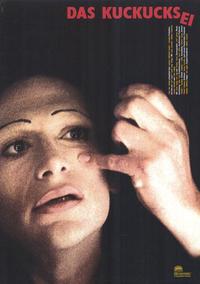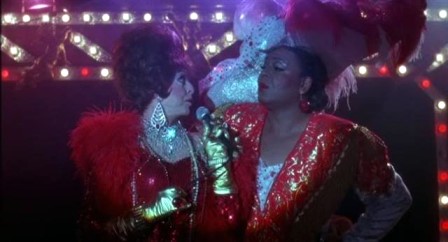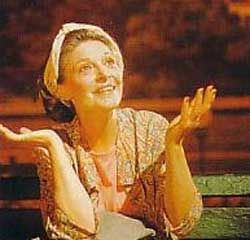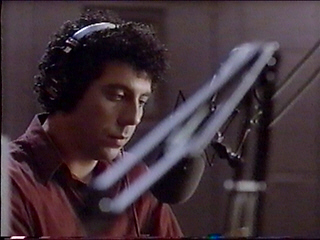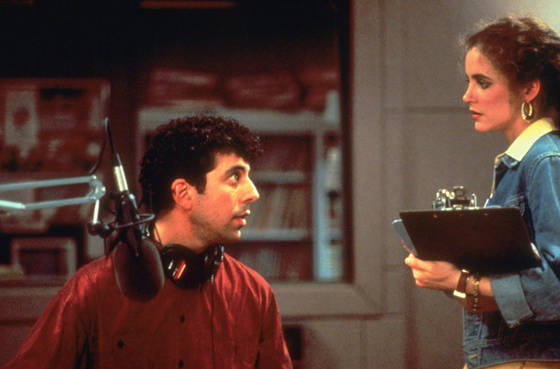From the Chicago Reader (December 23, 1988). — J.R.
TORCH SONG TRILOGY
*** (A must-see)
Directed by Paul Bogart
Written by Harvey Fierstein
With Harvey Fierstein, Anne Bancroft, Matthew Broderick, Brian Kerwin, Karen Young, Ken Page, and Eddie Castrodad.
TALK RADIO
*** (A must-see)
Directed by Oliver Stone
Written by Eric Bogosian and Stone
With Bogosian, Alec Baldwin, Ellen Greene, Leslie Hope, John C. McGinley, and John Pankow.
As different as they are, Torch Song Trilogy and Talk Radio, both movie adaptations of plays, have several striking things in common. Each was written by and stars the author of the original play — Harvey Fierstein and Eric Bogosian, respectively. Both deal with marginal aspects of American life that seldom find their way into the commercial mainstream, which makes them new and vital in ways that most other recent releases are not. Both are effectively (if not literally) one-man shows whose auteurs are more their Jewish writer-stars than their directors, and the impact of each is directly tied to the uncommon theatrical skills of these individuals. And perhaps most significantly, both are a good deal more professional, entertaining, intense, and compelling than any other new Hollywood releases around, even if their commercial fates are substantially more precarious than those of most of their competitors.
I haven’t seen a stage version of either play, but both works have apparently undergone substantial changes in their translations to the screen. Torch Song Trilogy began as three separately staged one-act plays dealing with the life of an outspoken professional female impersonator who hails from Brooklyn and works in a Manhattan club. It opened off-Broadway in 1981 and started a successful Broadway run the following year. The film has reportedly reduced the original material by about a third and pointedly relocated all of its action to the decade between 1971 and 1981, a period that predates the public awareness of AIDS.
Talk Radio, about a caustic radio talk-show host, started life as a performance piece staged by Eric Bogosian in Portland, Oregon, in 1985, with back-projected slides provided by artist Tad Savinar. It opened in an expanded version as a play in New York last year, with Savinar’s slides used simply as a scenic element. The movie drops the slides, shifts the action from Cleveland to Dallas, expands the play with material from Stephen Singular’s book Talked to Death: The Life and Death of Alan Berg, and adds a lengthy flashback.
While I can’t weigh the movie of Torch Song Trilogy against the play, it certainly works effectively on its own terms, even when it betrays its theatrical origins. After a brief prologue that shows the hero, Arnold Beckoff, as a child in Brooklyn in 1952, the movie leaps forward in time to the dressing room of the Manhattan club where Arnold (Harvey Fierstein) works. Arnold directly addresses the camera as he makes himself up for a musical number, and Fierstein’s command as a performer immediately takes hold. While his tete-a-tete with the spectator may initially suggest Cabaret‘s Joel Grey, Fierstein’s animated clownlike features and tragicomic show-biz persona actually hark back to an older tradition: the Jewish vaudeville associated with Al Jolson and Eddie Cantor (as well as Barbra Streisand) — a mixture of wisecracking irreverence and charismatic pathos that cuts into the material (“There are easier things in life than being a drag queen”) like a stiletto.
In its first two sections, the movie charts Arnold’s extended affairs with Ed (Brian Kerwin), a bisexual school teacher, and Alan (Matthew Broderick), a young model. In the third section, Arnold is single but living with a 15-year-old adopted son named David (Eddie Castrodad) who is also gay, and the main dramatic event is a visit from Arnold’s mother (Anne Bancroft), now living in Florida. This leads to a climactic confrontation in which Fierstein the performer finally meets his match in Bancroft; Jewish tradition, as well as sexual life-style, becomes the basis for the conflict.
Although Arnold is a fairly didactic character when it comes to defending his life, the movie itself is far from preachy, and part of its power derives from its portrayal of its major characters, especially Arnold and his mother, as complex individuals rather than as ideological mouthpieces. The question of how tolerant or intolerant Arnold’s mother is about her son’s homosexuality, for instance, is posed so intricately that viewers are likely to have a variety of opinions about it. Bancroft’s remarkable performance as a Jewish mother certainly has its caricatural side — it seems to derive in part from her wonderful role in Garbo Talks but it takes on layers and shadings that place it well beyond the realm of easy cliche. Ed and Alan’s ambivalent feelings about their own gayness are similarly endowed with a lifelike density, and if these characters finally register less fully than Arnold and his mother do, this appears to be only because the story’s theatrical structure deprives us of the opportunity to view them independently of Arnold.
Simply viewed as a movie about people, Torch Song Trilogy has the kind of wit, grace, and intense feeling that Woody Allen tried for unsuccessfully in Interiors, September, and Another Woman — a comparison that seems called for not only by the New York Jewish sensibility of both Allen and Fierstein, but because of the romantic, nostalgic taste for jazz and popular music that they share. (The dynamic use of popular songs in Torch Song Trilogy — ranging from Arnold’s indelible renditions of “Dames” and “Love for Sale” to Ella Fitzgerald’s version of “This Time the Dream’s on Me” — could be profitably studied by Allen.) If there’s any justice in the world, Fierstein’s high-powered entertainment will capture an audience much larger than Allen’s, for it actually delivers the emotional voltage and moral seriousness that Allen’s family dramas only aspire to before drowning in their own mannerisms. Whether there is any justice in the world is, of course, another matter.
The compelling aspects of Talk Radio are much less warm and humanistic, though no less theatrical. They depend on a nightmarish view of an underside of American life that is associated with call-in radio talk shows and the rage and delirium that they can both uncover and elicit. The hero in this case, or more precisely the antihero, is a glib talk-show host named Barry Champlain (Eric Bogosian), an aggressive radio personality who appears nightly on a Dallas station. Champlain’s popularity depends largely on his capacity to abuse most of the listeners who call in. He cuts them off in midstream and showers them with wisecracks and insults, regardless of whether they’re friendly or hostile.
Most of the movie is set in the studio while Champlaign is on the air, and Bogosian’s mesmerizing delivery and director Oliver Stone’s inventive mise en scene are perfectly matched in making these sections alive and electric. Though constrained by a subject that’s visually static, the film is far from still. Often Champlain paces around the studio; at other times it’s the camera or the set itself that’s in motion; but either way, the effect is invariably hypnotic.
Taken as a whole, the movie is a kind of morbid meditation on the sickness of both Champlain and his audience. Its strength derives not from any fresh sociological or psychological insight, but from the questions that it poses to a movie audience about the appeal of such sickness. Through its own fascination with Champlain and his listeners the audience is directly implicated.
Although Champlain is based in part on murdered Denver talk-show host Alan Berg, as well as such similar broadcasters as Morton Downey Jr., Barry Farber, David Gold, Bob Grant, Joe Pyne, Howard Stern, and Ed Tyll, he is not so much a character as a brilliant theatrical conceit, and the movie’s biggest mistake — damaging if not fatal — is to try to make sense of him as a character. This is clearly the rationale behind a flashback (reportedly added by Stone) that deals with the failure of Champlain’s marriage, his earlier work as a clothes salesman, and his gradual rise to fame as a radio host — a self-consciously overlit sequence that winds up rasing more questions than it can satisfactorily answer. For instance, Barry changes his last name from Golden to Champlain, which sits rather oddly with his aggressive assertions of his Jewishness on the air (which are apparently derived from Berg), but this isn’t a contradiction that the film chooses to acknowledge or deal with. (In the play, the character isn’t Jewish and his original surname is Paleologus.)
An unfortunate bias of conventional American movie taste is its preference for bogus psychology and perfunctory motivation over no psychology or motivation at all, under the assumption that everything in a fictional world has to be explained and accounted for. Yet the strength of certain fictional worlds rests in their refusal to offer the bromides of easy explanations. The tortured letters included in Nathanael West’s novel Miss Lonelyhearts and the blighted lives in his later novel The Day of the Locust are terrifying precisely because they suggest that certain human miseries have no solution or explanation. A similar terror is conveyed in some of the crank calls in Talk Radio — as well as in Champlain’s brutal responses, which are essentially cut from the same cloth.
This is the mysterious, provocative strength of Bogosian’s original material, and it forms the core of his driving, staccato performance. The best that can be said for Talk Radio‘s embroidery of Champlain’s personality is that it doesn’t dilute, or invalidate the movie’s power — it merely adds a surplus of detachable meaning for the sake of some spectators who couldn’t cope with Champlaign without some gesture towards explaining what makes him tick. (One such spectator, alas, is Larry King in the December issue of Premiere, who argues that the movie’s best scenes are the flashbacks, and chides the remainder of the film for not offering us chestnuts of wisdom.) But the film’s truly disquieting message isn’t the secret of Champlain’s personality or the psychology of lunatics and racists; it’s the seductiveness of Champlain’s sadomasochistic style of radio, which the film asks us to both experience directly and worry about from a certain reflective distance.
While reviewing Stone’s Wall Street last Christmas, I detected certain echoes of Elia Kazan and Budd Schulberg’s two collaborations, On the Waterfront and A Face in the Crowd, in that movie’s overheated, Manichaean dramaturgy. In the course of stretching out a play and trying to give it more of a plot, Talk Radio borrows again from A Face in the Crowd — particularly from its ruthless and exploitative media-star antihero, Andy Griffith’s Lonesome Rhodes — but not very much is clarified in the process. Giving Champlain a former wife who comes to visit (well played by Ellen Greene), in addition to the girlfriend (Lesley Hope) who was in the original, adds some interesting dramatic situations but some contrivances as well; and certain details from the life of Alan Berg that are superimposed on Champlain provide a comparably mixed blessing. But the meat of the material remains Champlain conversing with disembodied voices in a dimly lit studio, and Bogosian and Stone work wonders with it.

